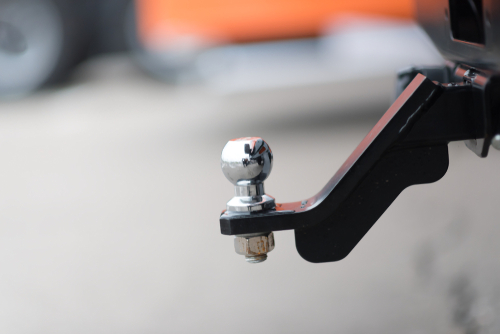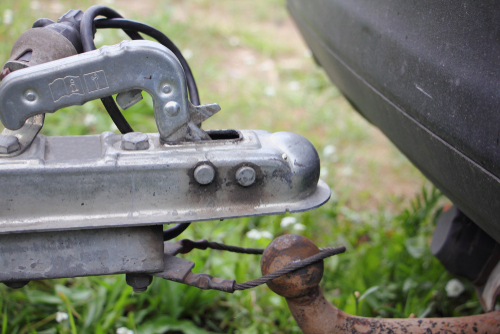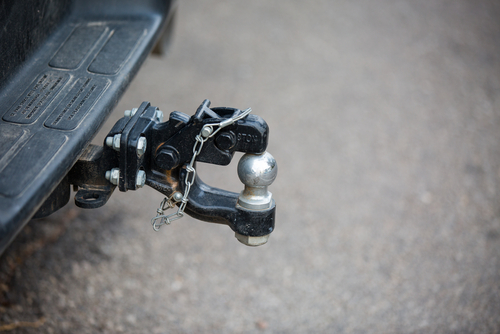Do All SUVs Have Hitches?
Do all SUVs have hitches? Why not? And why should I install one if it’s not part of the entire package when I buy my SUV?
Not all SUVs have hitches. It’s sad because having a hitch as a standard feature on your vehicle would totally increase its basic usability. A hitch allows you to perform a lot of tasks that normal cars can’t do.

A hitch makes it easier to attach a trailer behind your vehicle to tow stuff around. You can also use it for pulling other cars if there’s a roadside emergency and you want to help. Towing with a hitch makes it all safe and easy. And as long as you don’t go above your tow rating, having a hitch helps you avoid damaging your car’s framework.
What Is A Hitch?
What is it and why don’t all SUVs have hitches?
A tow hitch is a device attached to the chassis of a tow vehicle. This can either come in the form of a tow ball (to allow articulation or swiveling), a tow pin or a tow hook with a loop.
Not all SUVs have hitches because of safety reasons. And let’s face it—most SUVs today don’t really get used as workhorses. Most SUVs are treated as sedans that are just higher off the ground and are pampered like overpriced sports cars.
But then again, some people buy an SUV with the proper mindset and the lack of a tow hitch can be pretty limiting to these people that’s why aftermarket parts are widely available.

Hitches come in two general types: the first one is the receiver type, the second, a fixed-drawbar hitch.
Receiver Type Hitch
Receiver type hitches are attached to the rear of the frame of the vehicle. It has an opening that “receives” removable mounting devices. This can be anything from a basic rack for bicycles or a trailer.
The CURT 13333 Class 3 Trailer Hitch is a good receiver type hitch that you can get from Amazon.
Fixed-Drawbar Hitch
Fixed-drawbar hitches are built into the car where you can attach the ball of a mounting device.
Both have advantages and disadvantages over the other but are mainly different because of the price and the difficulty of attaching the hitch itself. When it comes to usability, both are equal in performance, so getting either one is still a good option for you.
A hitch can cost anywhere between $150 to $2,500.
Hitch Classification
There are four types of hitches. Each class has a specific maximum weight. You should take note of the ratings on each one.
First Class or Class I
Load limit: Zero-weight (barring the hitch weight) to 2000 pounds. These hitches are appropriate for smaller cars.
Get the CURT 45018 Class 1 Trailer for your car if you want to tow a trailer behind it.
Second Class or Class II
Load Limit: 2,001 pounds to 3,500 pounds. These can be installed on light trucks and mid-sized SUVs.
Get the CURT 45017 Class 2 Trailer Hitch Ball Mount for your SUV to tow a trailer safely behind it.
Third Class or Class III
Load Limit: 3,501 pounds to 5,000 pounds. If you have a full-sized SUV, this is the one for you. These are the big shiny ones that are easily seen on bigger vehicles.
For larger towing capacities, get the Reese Towpower 21536RAK.
Fourth Class or Class IV
Load Limit: 5,001 pounds to 10,000 pounds. These types of hitches are perfect for large workhorses. These are absolute monsters and you can never go wrong with these ones attached.
If those other classes aren’t big enough, then you need a Class IV hitch. Get the Armordillo USA 7167476 Class IV Hitch.

These hitches are only allowed to tow based on the rating recommended by the manufacturer for the vehicle. Therefore, you will still have to check your towing capacity before choosing what type of hitch is appropriate for your own SUV.
There are Fifth Class or Class V hitches that can carry 10,001 to 13,000 pounds, but this is subject to your vehicle’s rating and towing capacity for safety reasons.
You can get the Draw-Tite 41944 Class V Ultra Frame Hitch if you need a Class V tow hitch.
Aside from load-bearing hitches, weight-distributing hitches are also available in the aftermarket parts.
These hitches evenly distribute the weight of the load you are carrying to the front and rear axles of your SUV. This prevents damage on the rear and frame of the car as well as minimizing tow sag, which happens at the point of connection. These are usually assigned to Class IV or Class V tow hitches.
Are Tow Hitches Dangerous
There must be a reason why not all SUVs have tow hitches, right? Could it be that tow hitches are dangerous in some way?
Sure, there are definite advantages and disadvantages to having a tow hitch installed. The disadvantages are very minimal while the obvious benefits are very clear. It is still advised that you remove your tow hitch when you’re not planning on lugging anything behind you for an extended period of time, though.
Advantages Of Having A Tow Hitch
Only 40% of SUVs have tow hitches. This number includes those that have aftermarket hitches. The other 60% don’t know what they’re missing.
Having a tow hitch allows your SUV to perform tasks that it would normally not be able to do simply because of the absence of a connection point.
First off, it increases your towing capacity and ability. SUVs may have a lot of cargo space in the rear, but if you’re bringing a lot of equipment, that space can get pretty limited. If you’re thinking of bringing other recreational vehicles around, a tow hitch will make it pretty easy to do that.
Second, you now have more storage because you have a trailer acting as a separate compartment behind your towing equipment. Boats, motorcycles, tiny houses, campers, and others are easier to lug around with an appropriate tow hitch on your SUV.
Lastly, in the event of a rear-end accident, your tow hitch is the first thing the car behind you hits. Because tow hitches are extended from your frame and made of extremely solid and durable material, chances are you won’t incur any damage to your SUV.
But that’s also one of the disadvantages/dangers of having a tow hitch attached to your SUV.
Oh wait, there’s more. A tow hitch can add to your SUVs aesthetic appeal. Think of it as bling for your thing.

Disadvantages Of Having A Tow Hitch
Having a tow hitch is dangerous to cars and other obstacles behind you. These are nigh-indestructible pieces of equipment that can damage whatever it hits even at low speeds.
Removing and reattaching your hitch can be a very time-consuming process. If you let professionals do it, it could also drain your finances. Needless to say, learning how to do it yourself is a great way to save time, money and effort.
Speaking of money, tow hitches cost a large sum of money. The bigger you go, the higher the price point. Always consider the type of vehicle you have, what you’re expecting to tow, your vehicle’s rating and the tow hitch you can afford before buying one.
You’ll also need to give yourself an allowance when backing your vehicle to prevent hitting other things behind you. So, increasing your spatial awareness is key to driving safely with a hitch on.
Lastly, getting rear-ended can cause whiplash with or without a tow hitch attached. Studies have shown that there is 20% more chance of getting whiplash if you have your tow hitch on because of the impact from the other vehicle on that specific point.
How To Drive With A Hitch Attached Safely
Before we start, if you don’t need your hitch attached, have it removed. Hitches should only be present if you are planning on towing something behind you. If you’re not expecting to tow anything for a long time, remove your hitch for safety purposes.
Place a warning sign for other cars driving behind you to slow down as they approach to avoid hitting you in the process. A highly reflective sign is especially useful for these types of situations.

Install additional mirrors or a rearview camera to know where your car’s limits are at all times. It always pays to have an extra set of eyes to avoid damaging someone else’s property with your tow hitch.
Get Perfit Zone Towing Mirrors to get a better view of what’s behind you. You can also install rear cameras for more convenience. For this, the eRapta ERT01 Camera will do just fine.
Tow hitches aren’t a guarantee of safety at all times. Always check the connection points to ensure your tow hitch and whatever it’s towing behind it are still securely attached to one another. Prevent swaying with the CURT 17200 Trailer Anti-Sway Bar Control Kit.
For even better control, use the EAZ LIFT 48069 Elite Kit.
We’ve dedicated an entire article on doing that. And even though it’s for sports cars, you can still apply the same rules to your SUV. Check it here.
In Conclusion:
Not all SUVs have hitches. The main reason for that is it saves the manufacturer money by excluding it from the standard features on your vehicle. You can still go around this by installing one as an aftermarket option. You could also order a hitch to be installed by the manufacturer at an added cost. When not in use, you can attach the Bully CR-650L LED Hitch Step.
A hitch increases your SUV’s usability because it will allow you to tow large objects behind you safely. And having all that power under the hood, you owe it to yourself to get a hitch installed.
Related Questions:
Do I Need To Remove My Hitch When It’s Not In Use?
Yes. This is for your own safety. A hitch increases your length by six to ten inches, which is a considerable length. This can throw your spatial awareness of your surroundings and make you hit stuff when backing your SUV. Since hitches are solid, they can cause considerable damage to what you hit.
My SUV Doesn’t Have A Hitch, Can I Have One Installed?
Yes. All vehicles, even sedans, and tiny hatchbacks can have a hitch installed if it does not come as a standard feature. By now, you already know that not all SUVs have hitches and having one on your vehicle increases its usability. Having all that power is enough reason to tow a trailer around.
How Much Does It Cost To Have A Hitch Installed On My SUV?
$150 to $2,500. The huge price range is dependent on what type of hitch you want to be installed because not all SUVs have hitches as standard attachments. A standard hitch can cost you around $150 to $800. A gooseneck hitch is around $400 to $800 and a fifth wheel hitch is $500 to $2500.










